Part of a series of articles titled Alaska Park Science - Volume 20, Issue 2. Beringia: A Shared Heritage.
Article
The Fur Seals of Early American Alaska
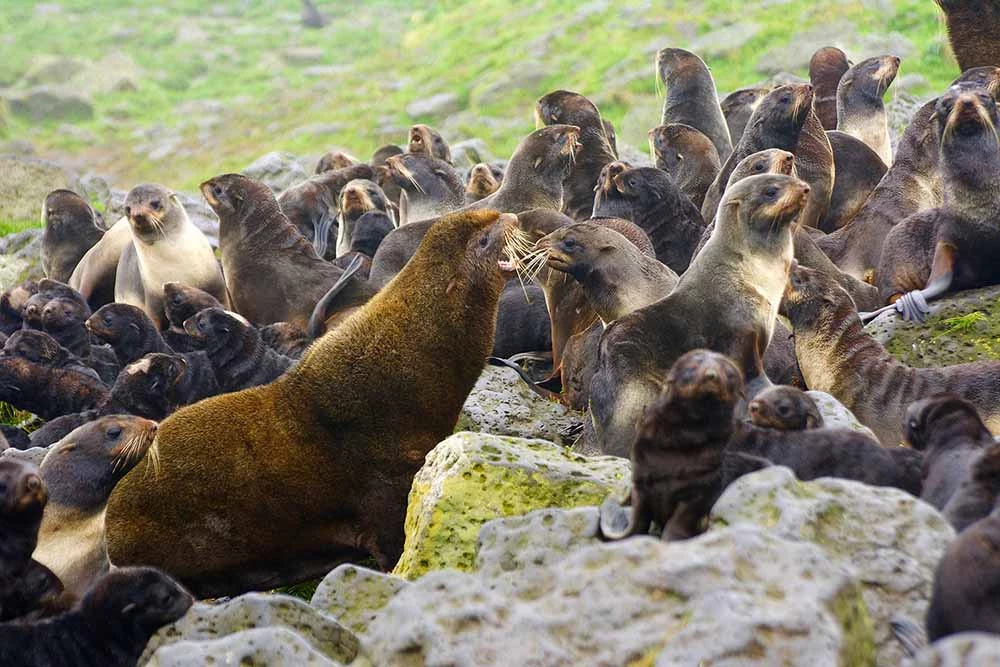
National Oceanic and Atmospheric Administration, Alaska Marine Fisheries
When the United States Government purchased Alaska from the Imperial Russian Government in 1867, the territory came with a lucrative fur seal industry. American Alaska inherited industrial infrastructure established by the Russian-American Company (Commander Island State Natural Biosphere Reserve 2018). But with the transfer of Alaska, the Russians did not simply disappear from the northern fur seal (Callorhinus ursinus) business. The United States’s rise as a North Pacific and Arctic authority, through the acquisition of Alaska, shifted the balance of power in the region but did not displace Russian interest in the fur seal resource spread across the North Pacific arc. Russian officials actually hired American hunters to harvest seals on Russia’s Commander Islands until, in 1911, the entire industry became too much of a diplomatic headache and Russians, Americans, Canadians, and Japanese came together to put an end to it (Ovchinnikov 1905).
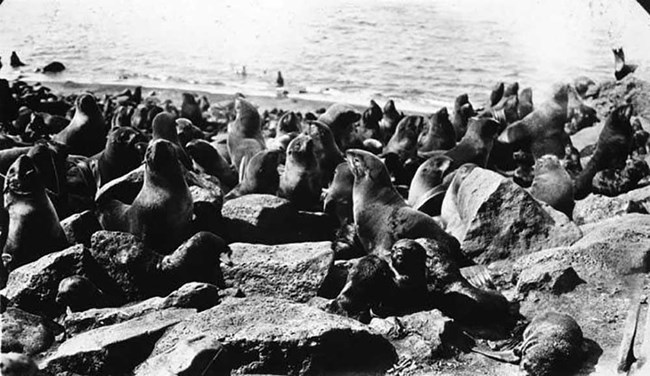
Ernest and Helen Watson Album, 1913-1939. UAF-2002-158-209. Alaska and Polar Regions Collections, Elmer E. Rasmuson Library, University of Alaska Fairbanks, Fairbanks, Alaska. Alaska’s Digital Archives. Used with permission.
At the time of the Alaska purchase, the American Government anticipated earning revenue through land-based fur-bearing animals (Appletons’ Hand-Book 1872). Yet arriving in Alaska by sea as they did, Americans quickly realized that marine mammals held more promise for profitability than land animals. While it is possible to hunt migrating fur seals strictly at sea by boat, mass slaughter is only possible on land, where fur seals gather on island rookeries to mate. The United States entered the land-based fur seal industry using abandoned Russian infrastructure on the Pribilof Islands, St. Paul and St. George, which included killing grounds and salt houses (Commander Island State Natural Biosphere Reserve 2018). A key element of that infrastructure was the Native workers—Unangax̂ people of the Aleutian Islands, who were forcefully relocated to the Pribilof Islands to hunt seals by the Russian-American Company. Americans came to know and care about fur seals through the purchase of Alaska and its “seal islands,” the Pribilofs, through the three-year process of establishing an American fur seal industry (1867-1870) and throughout its forty-year existence (1870-1910).
The United States becomes a Fur Seal Hunter
Henry Wood Elliott, the first American naturalist to study the Alaskan fur seal herd extensively, wrote that, by 1868, hundreds of Americans raced up to Alaska and “slaughtered over 360,000 young male seals within that season”—only stopping when they ran out of salt to preserve all of the skins so that they could make it out of Alaska and to the markets of the world (Elliott 1907). With no government to speak of, but with the promise of fast wealth, adventurists poured into the new territory (Ovchinnikov 1905). Eventually the U.S. Government—far away from Alaska in Washington, D.C.—learned of the unregulated massacre and declared the Pribilof Islands a reservation in 1869. The summer of 1868 free-for-all was followed by strictly Native subsistence hunting in the summer of 1869 (Elliott 1881). Congressmen in Washington then decided to restrict seal hunting to one entity, leasing the Pribilof Island seal fishery to a single company in twenty-year increments. It was such a lucrative industry while it lasted that hunters were unwilling to exercise restraint. This forced the governments of Russia, the United States, Canada (whose foreign policy was controlled by Great Britain), and Japan to reach a diplomatic agreement putting a stop to an unsustainable industry (Dorsey 1998). The fur seals thus organized and formed the basis for multinational relations in the North Pacific from 1867 until 1911, when representatives of the four North Pacific-bordering countries met to save the seals.
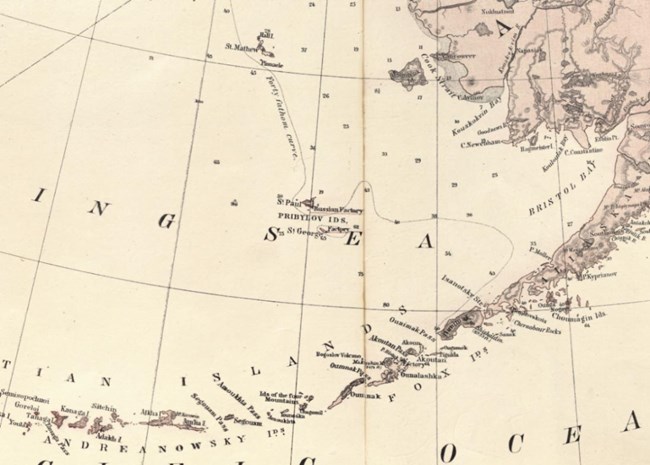
G4370 1867 U55 Map. Documents Collection. Alaska State Library Historical Collections, Juneau, Alaska. Used with permission.
The Alaska Commercial Company Lease: 1870-1890
It took the United States Government three years to decide what to do with its seal islands, their Unangax̂ residents, and their “factories”—various buildings designed for salting and storing seal pelts. In 1870, the American government brokered a lease with the Alaska Commercial Company (ACC) to hunt seals on the two Pribilof Islands (Busch 1985).
Since the U.S. Government granted twenty-year leases for sealing, American seal history in Alaska is divided into two neat periods, from 1870 to 1890 and from 1890 to 1910. The ACC lease lasted the first twenty years, followed by the North American Commercial Company (NACC), which took over the lease for the second twenty years. American convention delegates were willing to protect seals in 1911 because their country had just reached the end of a lease period (Busch 1985). It was a convenient time to change. Unsurprisingly, Russia was also willing to change, having just ended a lease period on the Commander Islands in 1911, while Canada and Japan were intransigent—not following the same system devised by the former and current owners of Alaska. The ACC paid the U.S. Government about $500,000 for the right to use government territory and government animals to make money. The company also paid a rent of $50,000 per year and a tax of $2 on each sealskin (Elliott 1881). During the first twenty-year agreement, the ACC collected an annual quota of 100,000 seals on the two islands combined. The quota total was based on an incorrect population count of 4.7 million seals in the 1870s (Elliott 1881). Two marine biologists from the U.S. who reevaluated the count in the mid-twentieth century determined that the real 1870s count was closer to one million (Roppel and Davey 1965). In the first year, the season started quite late, so the ACC only took 23,733 seals in its inaugural year (Busch 1985).
“Strike!”
How did the Americans kill seals on land? It was a procedure co-developed by the Russian foremen and Unangax̂ hunters who preceded the Americans to the Pribilof Islands. First, during the breeding season, hunters drove the “surplus” male seals (those that were able to reproduce but unable to attract any females) inland from the beaches in a brutal death march. The Unangax̂ would gather between the seals and the ocean around one or two o’clock in the morning and startle them into running further up the beach. Northern fur seals did not put up a fight this way, so just 3 or 4 Unangax̂ could send 1,000 seals up to the killing grounds. The drives ranged from 2.5 miles (4 km) to 5 miles (8 km), depending on the nature of the particular beach (Elliott 1881). The drive proceeded at about half a mile per hour; any faster and some seals would die from exhaustion. For the first 100 yards (91 m), a mature male fur seal could run at the same pace as a man. Beyond that, the seal would collapse (Elliott 1881). During the drive, the seals could take breaks to cool themselves with their flippers. These breaks were critical because too much sweat before death would devalue a seal’s coat. It would take several hours for the seals to reach the killing grounds. They would arrive worn out by six or seven in the morning. This process occurred only 40 days per year on the Pribilofs, which was enough time to reach the annual government quota of 100,000 harvested seals (Elliott 1881).
At the killing grounds, most Unangax̂ men from the Pribilof villages used oak or hickory clubs made in New London, Connecticut, to start the killing process (Elliott 1881). The foreman of the hunting party would yell “Strike!” and the clubs would usually stun, but not kill, the animals. Since the seals outnumbered the men, when the clubs met with the heads of some of the seals, others jumped to attention. Seals that escaped would be safe for that day, but they were likely to be rounded up in the next drive (Elliott 1881). Hunters needed to devote their undivided attention to the animals in front of them since seals occasionally lunged at hunters if the first, stunning blow did not render the animal unconscious. Sometimes, a seal would jump at a hunter and bite him just when the hunter was convinced the animal was dead. The hunters carried knives in case this happened but were discouraged from using them except in extreme cases. A knife mark would ruin the pelt (Elliott 1881). The pelt would also be useless as a coat if the fur stayed on the animal too long after death. It comes out in clumps quickly after death (Elliott 1881). The Unangax̂ bundled the skins of saleable condition in twos and sent them to an ACC steamship for transport—first to San Francisco, then to New York, then on to London (Elliott 1881). From there, most of them went all the way back to the Pacific region, to China (Elliott 1881).
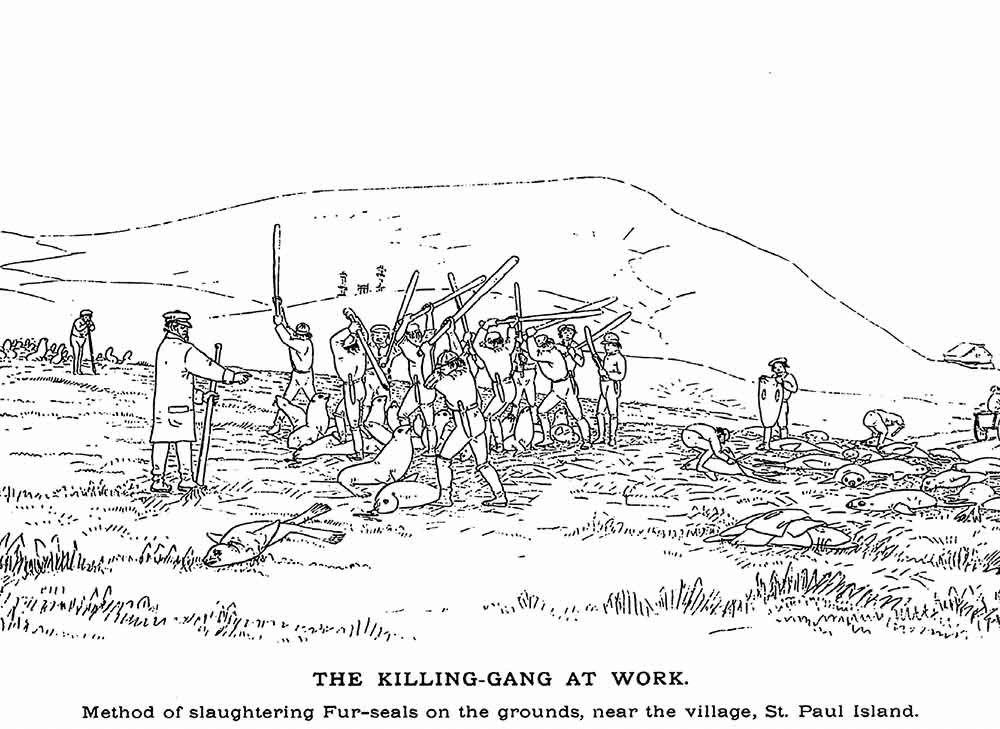
Elliott, H. W. 1881. The Seal-Islands of Alaska.
Government Printing Office
The North American Commercial Company Lease: 1890-1910
When the ACC’s lease expired in 1890, the U.S. Treasury Department gave control of the Pribilof Islands to the North American Commercial Company (NACC). The NACC bought the sealing infrastructure on the Pribilof Islands from the ACC for $67,264.82. The U.S. Government raised the annual rent from $50,000 to $60,000 and the tax per skin from $2 to $9.25. Government decisionmakers reduced the quota to a sum under 100,000 that could be changed year by year based on what still seemed sustainable at the time (Busch 1985).
Even in 1890, the government could see that the sealing industry would not survive. According to ACC records, that company harvested 2,006,136 seal skins in twenty years. The NACC, on the other hand, took only 359,462 in the same number of years (Busch 1985). The problem was not that the NACC was less efficient; it was that the Pribilof northern seal herd was rapidly declining. Company profits were not immediately affected since, as supply decreased, demand stayed the same and even increased. Thus, the value of each skin increased. The sealskin coat was very fashionable in the 1870s and continued to be so in the 1890s. Each coat was worth about $150-$200 in the 1880s (Busch 1985). Although each pelt grew in value, company profits remained stagnant and Unangax̂ workers’ salaries—which actually came in the form of relief payments and not real salaries—declined.
In 1903, the U.S. Government shifted jurisdiction of Alaska from the Treasury Department to the new Department of Commerce and Labor. In 1909, control of Alaska shifted again, to the Bureau of Fisheries within the Department of Commerce and Labor (National Oceanic and Atmospheric Administration Fisheries 2019). These shifts did not change the fact that Alaska’s role in the United States in those years was to generate revenue. With each passing year, authorities recognized that the seal islands would not generate revenue forever and would soon cost more to maintain than they produced. When the NACC lease ended on April 30, 1910, the government prohibited seal hunting on the Pribilof Islands indefinitely. This prohibition made it easy to partner with Russia, Japan, and Canada to save the seals via the North Pacific Fur Seal Convention the following year (Nagel 1910).
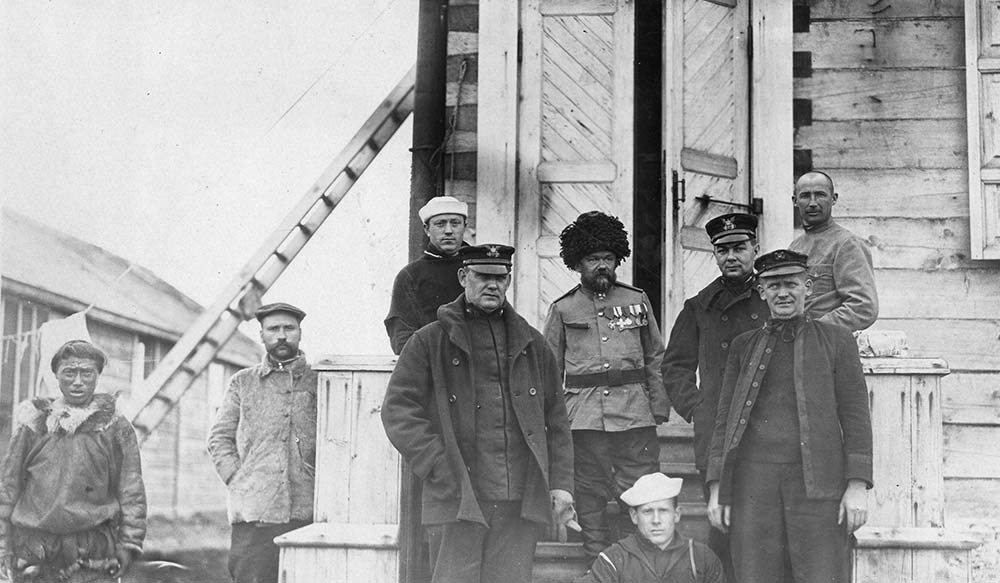
From the collection of the commanding officer of the United States Revenue Cutter Bear. Cochran Collection: B1981.164.7. Anchorage Museum Library and Archives, Anchorage, Alaska. Used with permission.
The ACC Goes to Work for the Russians
Russia retained islands with fur seals even after it sold Alaska, though this is rarely discussed in the English-language literature on the fur seal industry. The westernmost Aleutian islands are actually a part of Russia’s Commander Islands, had many resident fur seals of its own (Elliott 1881). Ironically, Russia offered a lease to the ACC. It began in 1871, the year after the ACC contracted with the U.S. Government to work the Pribilofs. The company paid 5,000 rubles (about $4,000) annually to the Russian Government for the right to hunt on Bering Island and two rubles, or about $1.50, per skin (Ovchinnikov 1905). Initially, the ACC called its Russian branch Hutchinson, Kohl, Maksutov and Company, in part named for Prince Dmitrii Petrovich Maksutov, the last governor of Russian Alaska. As soon as the lease began, the ACC took over and Maksutov was barely involved. With that lease, the company had a monopoly over almost every seal residing on land on both sides of the Pacific basin (Busch 1985).
On Russia’s Commander Islands, ACC foremen hired Unangax̂ laborers to hunt seals in Russian waters, using methods co-created by Russians and Unangax̂ and then transferred from the Unangax̂ to the Americans. For twenty years, from 1871 to 1891, the ACC harvested 769,893 seals on the Commander Islands (Busch 1985). Although the U.S. Government did not renew its contract with the ACC after the first twenty years, the Russian Government did. Thus, the ACC hunted Russian seals until 1911 (Ovchinnikov 1905). Even the U.S. Treasury benefitted financially from this arrangement, garnering about $550,000 in tax payments over twenty years from American hunters working in Russia for the Russian Government (Busch 1985).
The End of the North Pacific Conflict over Seals
The United States and Russia saw their land-based seal leases end in 1910 and 1911, respectively. This positioned both countries to lobby for a new normal in North Pacific relations in 1911. Americans, Russians, Japanese, and Canadians knew that they were fighting a losing battle against the fur seal and its population’s survival (Ovchinnikov 1905). With a declining annual yield, the tremendous costs required to patrol the region for illegal hunting, and the costs involved in paying Unangax̂ hunter wages, the American seal industry finally showed itself to have the same failing business plan as the Russian-American Company four decades earlier (Vinkovetsky 2011).
The four-nation North Pacific Fur Seal Con-vention met in 1911 to put an official end to pelagic sealing, or the hunting of seals on the open sea, in waters north of 30°N latitude. Multinational agreements are needed to manage international waters, whereas countries are free to do as they wish on their own territory. But the United States, Russia, Great Britain (Canada), and Japan voluntarily halted fur seal hunting on land too, for several years after 1911, to allow the population to recover (Dorsey 1998). The convention prohibited all pelagic sealing in the North Pacific for a period of fifteen years—but that period extended much longer because the signatories supported its continuation without controversy (Collection of Laws and Regulations Issued by the Senate 1911).
The participants determined what each country would owe the others on the basis of the size of each country’s rookery. Since both the U.S. and Russia had large sealing grounds and Canada and Japan were mostly engaged in pelagic sealing, the former agreed to give the latter fifteen percent of their revenues each (Collection of Laws and Regulations Issued by the Senate 1911). The U.S., having the most successful seal hunt prior to the convention, immediately gave $200,000 to both Japan and Canada. While Japanese and Canadian seal hunters did not feel lucky to have their livelihoods taken away, their governments were pleased to essentially get something for nothing. The Russians and Americans exchanged nothing because they owed each other nothing as near equals in the fur seal industry (Gay 1987). The North Pacific Fur Seal Convention was the first of its kind, protecting a single animal species through successful multinational cooperation.
The Evolution of the Industry and Future of the Fur Seal
In the decades after the fur seal convention, Japan was the only signatory to change its mind about saving the seals. It relied economically much more on the wealth of the oceans than did the American, Russian, or British empires whose economic centers were far away from the North Pacific (Tsutsui and Vuorisalo 2017). The Japanese announced that they were backing out of the 1911 convention in October 1940 and the treaty ended one year later, as the convention stipulated a twelve-month advanced warning (Dorsey 1998, Gay 1987, Roppel and Davey 1965). The U.S. and the (by then) Soviet Union resumed limited rookery sealing and continued to send a portion of their land-based seal profits to Canada and Japan until 1940. Sealskin coats eventually fell out of fashion, especially as synthetic alternatives to animal skin coats arose in the twentieth century. The Alaska Commercial Company adapted as well, developing into a retail company. The ACC name lives on today—not for hunting seals, but for selling groceries to residents of twenty-seven small towns and villages across Alaska.
Despite the fur seal treaty’s promise in 1911, in 2021 it is clear that, even if hunters stop going after a protected species, the habitat and prey loss caused by rapidly worsening climate change may destroy that population anyway. The most recent estimate of the global northern fur seal population (in 2014) was 1.29 million animals. This includes 650,000 mature individuals (of reproductive age), and the population is in decline. The International Union for Conservation of Nature, which offers the most comprehensive global animal population data, calls the northern fur seal “vulnerable” (Gelatt et al. 2015). Thankfully, “vulnerable” is several steps away from “extinction,” with “endangered,” “critically endangered,” and “extinct in the wild” between the two categories. There is still time to address the population loss of the animals that northern fur seals eat: walleye pollock, sand lance, herring, smoothtongue, mackerel, and salmon (National Oceanic and Atmospheric Administration Fisheries 2019). Other threats to the northern fur seal population are its tendency to get caught in fishing gear, its role as the ideal meal for killer whales (orcas), its sensitivity to the negative effects of oil spills, habitat degradation, human presence, disturbance by marine vessels or aircraft, chronic pollution, and illegal harvests (Gelatt et al. 2015).
Acknowledgements
I would like to thank my doctoral committee at Cornell University, which contributed to the research that appears in this article: Penny Von Eschen, Claudia Verhoeven, Matthew Evangelista, and Ernesto Bassi. I am grateful to Alexander Petrov at the Institute of World History of the Russian Academy of Sciences in Moscow for sponsoring my Russian research visa. This research would not have been possible without the financial support of Cornell University, especially via the following fellowships and grants: the Luigi Einaudi Graduate Dissertation Fellowship, the Sage Fellowship from the Graduate School, the Ihlder Fellowship from the Department of History, the Pre-Dissertation Summer Research Grant from the Department of History, the Graduate School Research Travel Grant, the Einaudi Center International Research Travel Grant, the Society for the Humanities Graduate Travel Grant, and the American Studies Graduate Research Grant.
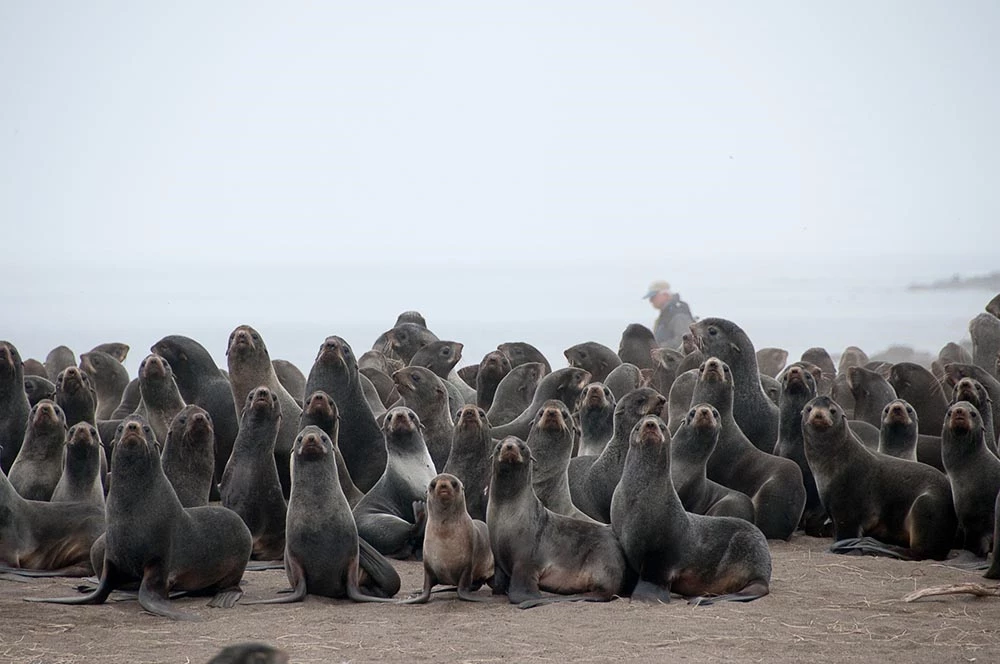
National Oceanic and Atmospheric Administration, Alaska Fisheries Science Center/Dave Withrow
References
Appletons’ Hand-Book 1872.
Appletons’ Hand-Book of American Travel: Western Tour. D. Appleton and Company, 317 pp.
Busch, B. C. 1985.
The War Against the Seals: A History of the North American Seal Fishery. McGill-Queen’s University Press, 374 pp.
Collection of Laws and Regulations Issued by the Senate: Convention for the Protection of Fur Seals. 2011.
Rossiiskii gosudarstvennyi arkhiv voenno-morskogo flota (RGAVMF) fond 417 (Main Marine Headquarters), opis’ 1, delo 4373.
Dorsey, K. 1998.
The Dawn of Conservation Diplomacy: U.S.-Canadian Wildlife Protection Treaties in the Progressive Era. University of Washington Press, 328 pp.
Elliott, H. W. 1881.
The Seal-Islands of Alaska. Government Printing Office, 176 pp.
Elliott, H. W. 1907.
The loot and the ruin of the fur-seal herd of Alaska. The North American Review 185 (617): 426-436.
Gay, J. T. 1987.
American Fur Seal Diplomacy: The Alaskan Fur Seal Controversy. Peter Lang, 167 pp.
Gelatt, T., Ream, R., and D. Johnson. 2015.
Northern fur seal: Callorhinus ursinus. International Union for Conservation of Nature (IUCN), Red List of Threatened Species. Available at: https://www.iucnredlist.org/species/3590/45224953 (accessed March 26, 2015)
Nagel, C. 1910.
Regulations for the Protection of Fur-Bearing Animals in Alaska. Department of Commerce and Labor, Bureau of Fisheries, Office of the Secretary, June 2, 1910. Washington, D.C. Department Circular No. 206, Folder 1326: Legal Papers, Fur Regulations and Sea Otter Hunting, 1910-1911. Box 139: Legal Papers – Photographs 1869-1929. San Francisco, California. Alaska Commercial Company Records, 1868-1913, USUAF3. Alaska and Polar Regions Collections, Elmer E. Rasmuson Library, University of Alaska Fairbanks, Fairbanks, Alaska.
National Oceanic and Atmospheric Administration Fisheries. 2019.
Northern fur seal research and management, 1900-39. Alaska Fisheries Science Center Historical Corner. Available at: https://www.afsc.noaa.gov/History/research/fur_seals2.htm (accessed August 14, 2019)
Commander Island State Natural Biosphere Reserve. 2018.
On the Importance of a Proper Count: Lessons from History. March 5, 2018. Available at: komandorsky.ru/о-важности-корректных-оценок-численности.-уроки-истории.html (accessed February 26, 2020)
Ovchinnikov, I. A. 1905.
Arbitration in the Matter of the Seizure of American Schooners by Russian Cruisers. Rossiiskii gosudarstvennyi arkhiv voenno-morskogo flota (RGAVMF) fond 417 (Main Marine Headquarters), opis’ 1, delo 3485.
Roppel, A. Y. and S. P. Davey. 1965.
Evolution of fur seal management on the Pribilof Islands. The Journal of Wildlife Management 29 (3): 448-463.
Tsutsui, W. M. and T. Vuorisalo. 2017.
Japanese imperialism and marine resources. In S. Laakkonen, R. P. Tucker, and T. Vuorisalo, eds. The Long Shadows: A Global Environmental History of the Second World War. Oregon State University Press, 368 pp.
Vinkovetsky, I. 2011.
Russian America: An Overseas Colony of a Continental Empire, 1804-1867. Oxford University Press, 276 pp.
Last updated: December 15, 2021
